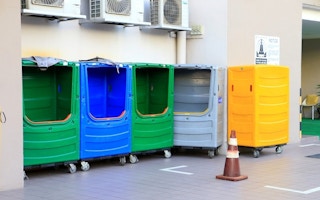You may not be able to hear or see it, but around the island, thousands of litter bins, trash cans, and neighbourhood waste compactors are silently broadcasting to cleaning crews when they are full, beckoning to be emptied.
This is just one of the many ways that the Internet of Things is having a profound impact on daily public services, where ordinary, everyday objects such as waste bins and soap dispensers are networked and connected to each other and to the information superhighway. Amid rapid urban growth, the Internet of Things can make cleaning and waste management more efficient for healthier, more liveable cities.
The number of connected devices is burgeoning: a report last year from technology consultants Juniper Research estimated that the number of connected devices will nearly triple in the next five years, from 13.4 billion in 2015 to 38.5 billion in 2020.
Proponents of IoT say these technologies can offer advances in efficiency and productivity for the cleaning and waste management industries, and the sector is beginning to sit up and take notice.
At next month’s CleanEnviro Summit Singapore, experts from industry and government will discuss how cleaning firms can navigate the plethora of IoT offerings to increase their productivity and deliver better service.
The event, which will take place on July 10 to 14 alongside the World Cities Summit and Singapore International Water Week, is expected to attract 20,000 people from more than 100 cities.
One key highlight of this year’s summit is the City Solutions Singapore expo, where over 900 leading companies and start-ups in urban development, water and waste management will showcase their products.
“
Besides raising productivity, other benefits include new insights arising from the data thus collected through IoT systems, which could potentially open up new business opportunities.
Patrick Pang, chief technology officer, National Environment Agency (NEA)
IoT has several key benefits for cleaning, CleanEnviro Summit managing director Dalson Chung tells Eco-Business.
Typically, cleaning crews make scheduled rounds to clean bathrooms or empty bins. This can be an inefficient use of manpower.
Sensors, however, can identify usage patterns, such as when certain bins are likely to be full, and cleaning rounds can be scheduled to match these, thus raising productivity.
Similarly, tracking toilet usage, paper towels, and hand soap in restrooms enables cleaning operators to serve bathroom users better. At the same time, machines can also be automated and controlled remotely to carry out tasks, freeing up manpower.
Over a longer time period, the continuous data stream from connected devices yields “critical intelligence for trend identification, equipment maintenance and efficient cleaning”, Chung says.
“With this intelligence, everyone from building managers to health officials gains a deeper insight into how occupants and visitors interact with their environment, keeping buildings clean and the people inside them healthy and safe,” he adds.
Already, Singapore is exploring the use of IoT devices such as in waste bins.
Patrick Pang, the chief technology officer of Singapore’s National Environment Agency (NEA), says its litter bin management system, comprising position sensors and fullness-level sensors, are installed on the roughly 10,000 litter bins the agency manages.
“Through the [system], NEA officers use mobile devices to remotely monitor the progress and status of cleaning works and public cleanliness situation.
“With better awareness of the ground situation, NEA is able to respond to cleanliness feedback quickly and enhance our audit and inspection capabilities,” he says.
For instance, fullness sensors are installed at locations where bins often overflow, such as the shopping district Orchard Road and key transit hubs with busy foot traffic.
In addition, in the public housing district of Yuhua in western Singapore, sensors alert waste collectors when large compactor bins are full, and summons the nearest waste collection truck to clear the bin.
“The system not only facilitates the move towards needs-based waste collection, it also optimises the deployment of resources and improve service delivery,” Pang adds.
There are obstacles, however, to the growth of IoT devices in waste management.
For one thing, the cost of a high-tech feature is a large proportion of the price of a simple device like a soap dispenser, notes EUnited Cleaning president Marcus Asch.
“It is much easier to equip expensive machines with all the technical features rather than more simple products,” he says.
But networked soap dispensers can pay off in the long run if they lead to productivity improvements, says Asch, who leads the European Cleaning Machines Association and will be speaking at the CleanEnviro Summit Singapore.
Also, an IoT system has to be designed and maintained on the assumption that individual nodes in the sensing network may break down, run out of battery, or give incorrect readings from time to time, says the NEA’s Pang.
“Operational costs would still need to be managed carefully, in order to justify the benefits obtained. In particular, a key aspect of IoT is the continued operations and management of the individual sensing nodes,” Pang adds.
Finally, as commercial IoT offerings balloon, it is vital to ensure devices are standardised to speak the same language, so to speak, and that they can be integrated with wider networks, Pang says.
Once these obstacles are overcome, what’s next for IoT use in the cleaning industry?
One future trend is to integrate machines with buildings. That’s not a sinister cyborg future – a rather prosaic example Pang gives is allowing robotic floor scrubbers to ‘talk’ to a building’s lift system, so they can ride the lift and access all the building’s floors with no human operator needed.
And the IoT will deliver a mountain of data for as-yet-unforeseen uses.
Pang adds: “Besides raising productivity, other benefits include new insights arising from the data thus collected through IoT systems, which could potentially open up new business opportunities.”









